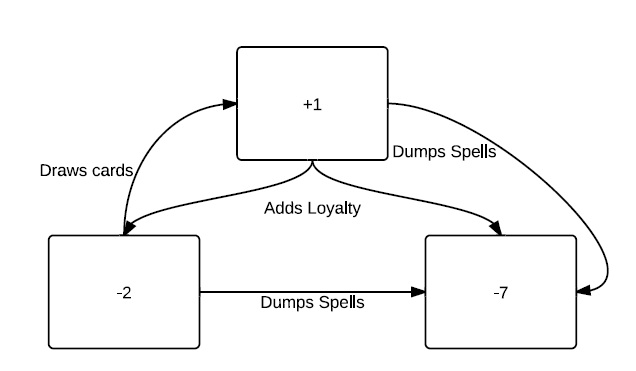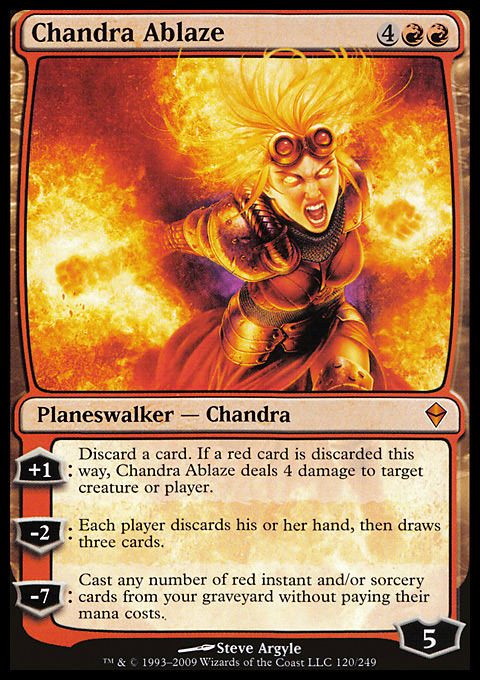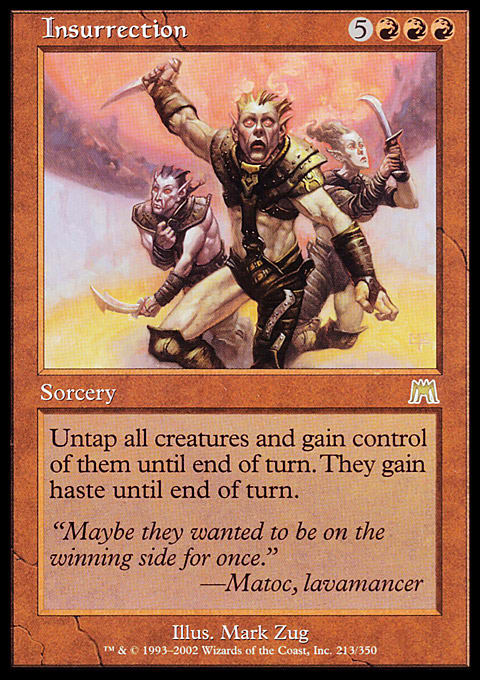Over the past few weeks, I’ve been doing a design-minded review of the Magic 2013 core set, but for the moment, we’re going to give that a rest in favor of a topic even more exciting than the game’s most recent expansion: planeswalkers.
Since Lorwyn, our reality-hopping friends have taken the spotlight, and they have no intention of giving it back, nor should they. Planeswalkers are awesome. They allow us to explore a multitude of worlds while keeping familiar faces around; they combine magics from across the multiverse in new ways just like players do; and in our post-Mending world, they manage to be relatable while doing all that.
How exactly does one keep a character like that believable? Not my area of expertise. Luckily, I’m not the only one writing about our favorite mages right now—this week, GatheringMagic has everything you’ve ever wanted to read about planeswalkers. Around the website this week, you’ll find Brendan Weiskotten’s, Daryl Bockett’s, and Brandon Isleib’s articles covering all sorts of impacts the cards have, but in this particular column, our focus is on how one actually comes up with the rules text and numbers for a new ’walker. And make sure to stay tuned for a special contest at the end of the article!
Getting into Character
In recent years, we’ve been seeing a lot more flavor-driven design. But in the words of one Mr. Rosewater, “Flavor is more flexible than mechanics,” so when push comes to shove, cards often are reflavored later in the process. Not so with planeswalkers. Like legendary creatures, planeswalker cards are intended to showcase the personality they represent in the story. Not all of them succeed, and you should read Brendan’s coming article for more on that, but capturing the character’s personality is the primary goal of any planeswalker design.
In order to accomplish this goal, a designer needs a deep understanding not just of how abilities play, but what they feel like. Sorin Markov’s ultimate gives the user a taste of schadenfreude; Elspeth, Knight-Errant’s gives a sense of security; Chandra Ablaze’s feels like an explosion. These effects are big and splashy, but the same phenomenon occurs everywhere. From Surgical Extraction to Shieldmate's Blessing, most effects give their users a sense of intent, and a planeswalker’s abilities need to give off the same aura that their personality does.
Stick to the Canon
Top-down design of the nature described above certainly isn’t easy, but if that were our only restriction, making planeswalkers wouldn’t be a big deal. Let’s just say that’s not the case. Planeswalkers are the most difficult card type to design because they have a truly ludicrous number of restrictions on them and they receive the most scrutiny since they’re almost always the marquee cards of their sets.

Image by Casey Fleser on Flickr
So while abilities that show Chandra Nalaar being a hothead is great, you can’t just stick Blind with Anger on her next card. Chandra’s a pyromancer; she doesn’t know spells that control people’s emotions, and while the card needs to represent her mindset, it also needs to show off her actual capabilities.
Voltron Assemble!
Up to this point, we’ve been talking about requirements that each ability needs to fulfill, but a planeswalker card must be more than the sum of its parts. One of the most important lessons I learned from Chah when working with him on the Goblin Artisans M13 project is that you can’t just consider how a card’s going to feel when it’s played—you have to figure out how it’s going to shape the course of a game it’s involved in.
In some ways, planeswalkers are the easiest card type to do this for because their impact on the game is so enormous. When your opponent drops a ’walker, you’re usually going to lose if you can’t kill it, which in turn means that you suddenly drop your prior game plan in an attempt to mitigate the current threat. As for why this is the case, most people cite the card type’s ability to generate card advantage. That’s certainly a factor, but you didn’t see the same dynamic with advantage-generating enchantments back in their day because the only option was to race.
The fact that planeswalkers can be attacked makes them easier to deal with, and thus they’re allowed to be more dangerous when not dealt with. So most ’walkers don’t just provide a card per turn, they grow more powerful with each activation because their abilities feed one another. Take, for instance, Chandra Ablaze:
Her first ability allows you to pitch a red card to protect herself. Her second ability allows you to make up for all the cards you’ve discarded with the first one by bringing your opponent down to your level while refilling your hand. Her final ability uses the resources her first two abilities provide to (ostensibly) finish the game. Or, in flow chart form:

This is great because each of the abilities connects to every other one, but that’s not always possible. Still, you need a pretty good reason to stick a completely unconnected ability on your planeswalker, so try to make sure that each ability has a positive interaction with at least one other. It’s cool that all three of Venser, the Sojourner’s activations feel like teleportation, but his second ability is completely at odds with the other two. And those are only tenuously connected by the fact that he encourages you to bounce your own creatures with Aether Adept.
Kicking Things up an Energy Level
All of the above points are important for making your planeswalker card a cohesive representation of a character, but at the end of the day, it’s still a mythic rare. When players see a new planeswalker, they need to be excited.
As humans, we’re very good at imagining best- and worst-case scenarios, and we’re not very good at figuring out what’s usually going to happen. That means that when you’re in the business of making things exciting, you want to minimize the apparent risk and maximize potential reward. An ultimate ability that’s hard to activate should do something big that players will dream about, the loyalty-adding ability should always be useable, and the card should always make an impact when cast.
This is, in my mind, is Tibalt, the Fiend-Blooded’s failure. Sure, Insurrection is cool, but it’s easy to look at the card and say, “All I can do is loot.” The fact that the looting had to be random for power-level reasons means that the vast majority of players don’t even view it as a net positive, and as such, they were scared off. On the other hand, Tamiyo, the Moon Sage is as popular as she is mostly due to all the sweet things players can dream of doing with her emblem, but even her middle ability encourages dream sequences.
Son, I Am Disappoint
So, the things that make a planeswalker look good aren’t necessarily the same as the things that actually make one powerful, but most ’walkers need to deliver in both arenas. It’s great if people buy the new set because they’re excited by the cards, but when little Jeremy opens up a powerful-looking planeswalker, it had better actually be good when he plays it. Magic’s business model doesn’t allow for double-crossing the customers; the average player keeps at it for nine years! Obviously, not every ’walker can be one of the top cards in Standard, but they should all be good at what they do. *coughSarkhan Volcough* Ahem, excuse me—dragon stuck in my throat. Where were we?
F Is for Friends Who Do Stuff Together
In short, a planeswalker needs to embrace its character’s personality and capabilities, create rewarding gameplay patterns, look powerful, and be powerful in a different way. That’s a tight space to squeeze into, but on top of it all, planeswalkers are still Magic cards, and above all else, they must be fun to play with. As promised, designing a good planeswalker is no easy task, but that just means it’s a great way to challenge yourself as a designer. So how’s about a learning experience?
Walking the Walk
In the coming week, I want you to design a planeswalker. You’re absolutely free to make your own character, use an existing ’walker, or even have a legendary creature ascend to planeswalker status. What’s important is that you know the character you’re designing for.
The top submissions will each earn a spot in an upcoming article here on GatheringMagic. And I’ll be taking them from now until midnight going into Tuesday, August 14. To make a submission, please send an e-mail to julesdrobins at gmail dot com including your planeswalker design, the name you want to be acknowledged by, a short snippet of backstory about the character, and a blurb about the design of the card—all totaling fewer than one thousand words.
To get the gears turning, you might want to check out the planeswalker bios on DailyMTG or the actual cards. I’m looking forward to seeing what you come up with for this one!




























